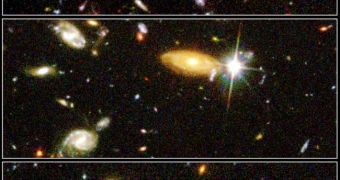When cosmologists looked to see what happens at the boundaries of the Universe, they noticed something that no one expected – a tendency of the most massive galaxy clusters in existence to head towards a single hot spot in space. Why this happens is still a mystery.
Exploring the boundaries of the known Cosmos is a very tricky task, and yet one that can be attempted using modern scientific means. What astronomers can do is measure the speed and direction at which galaxies, clusters and superclusters are moving.
Such studies have revealed a general tendency among the largest-scale cosmic structures to head towards a single point in space. Astronomers have yet to figure out why this is happening, but several explanations have been proposed.
Interestingly, all the objects heading towards that point in space travel at speeds reaching 800 kilometers per second. The reason why this is bizarre is that cosmological models hold that all objects at the edge of the Cosmos should be traveling at equal speeds in all direction.
Instead, what is being noticed in actuality is tendency for matter to prefer a certain direction. “The clusters show a small but measurable velocity that is independent of the Universe's expansion and does not change as distances increase,” explains Alexander Kashlinsky.
“We never expected to find anything like this,” adds the expert, who was the lead researcher on the new study. He holds an appointment at the Greenbelt, Maryland-based NASA Goddard Space Flight Center.
In the astronomical community, this discernible motion among large-scale cosmic structures that is independent of expansion is called the dark flow. “The distribution of matter in the observed Universe cannot account for this motion,” Kashlinsky says of the root of this problem.
As a side note, it was the exact same issue that has forced astronomers to develop the concepts of dark energy and dark matter. Apparently, there is insufficient mass in the observable Universe to account for the strength of gravitational forces that determine how galaxies, clusters and superclusters interact.
One of the proposed explanations for this was that the structures were heading for a black hole. This is impossible for two reason – first, you would need a really big black hole, and second, objects would accelerate towards it, not maintain a constant speed.
Find a method to explain dark flow is made extremely difficult by the fact that its mere existence is calling into question seemingly-established facts about the Universe, such as the way it expands and the forces influencing this process.
University at Buffalo researchers recently shows that supernovae – the final explosions of massive stars – do not move in sync throughout the Cosmos, as previously thought. In a forthcoming issue of the Journal of Cosmology and Astroparticle Physics, they detail their investigation of 557 supernovae.
“Our result is boring, in a way, because it matches your expectation for the standard cosmological model,” explains William Kinney, who holds an appointment as a physicists at UB.
“If it turns out that the NASA team led by Alexander Kashlinsky is right, it would be exciting because there would be some crazy thing going on that nobody understood,” he adds, quoted by Daily Galaxy.
“There would have to be something very radical, like a big mass outside of our universe that's pulling on stuff inside our universe. That would be big news,” the expert goes on to say.
But, “with our study, we're muddying the water. It's not yet clear who is right. We have to do more figuring to build up a more detailed and accurate picture of the Universe,” he concludes.

 14 DAY TRIAL //
14 DAY TRIAL //